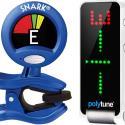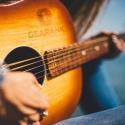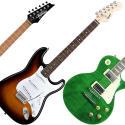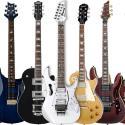Everything You Need to Know About Guitar Frets

Guitar frets are an essential element of guitar playing.
Here we will talk about how frets work, their purpose on a guitar, and explore the significance of fret wires.
In this article, I'll talk about
-
What Are Guitar Frets?
-
What Are Guitar Fret Wires For?
-
Why Are Frets Important?
-
How Many Frets Does My Guitar Have?
-
Common Fret Wire Materials
-
Fret Sizes
I'll also share some insights at the end. Let's start by defining guitar frets.
What Are Guitar Frets?
Guitar frets are the space between fret wires where you press the strings for different notes.
The fret wires divide the strings into distinct intervals, allowing for accurate intonation.
Each fret represents the different notes on the fretboard as you pluck the strings.
What Are Guitar Fret Wires For?
Guitar fret wires are thin metal strips attached to the fingerboard. They are spaced at very precise intervals, with each space representing semitone (half-step) intervals.
Fret wires have three parts: the “crown or bead” at the top and a thinner “tang” with "barbs or studs" on its sides (inserted into the fingerboard).
Guitar fret wires are sometimes used interchangeably with the term guitar frets. But there is an important difference: you don't "fret" on the wires!
It is crucial to understand that guitar frets are not the fret wires themselves, but the space in between them.
As a teacher, I make it a point to emphasize this to all my students, in order to prevent this common beginner mistake.
Why Are Frets Important?
Frets help you (the player) achieve standard intonation and play notes accurately. They serve as guides that let you visualize what the notes are on every part of the fingerboard.
Pitch Control
When you press down (fret) a string on a fret, the vibrating length of the string gets shorter, which results in changes in pitch. As you pluck the same string and move higher up the frets (closer to the body), the pitch of the note gets higher. When you get to the twelth fret, you'll find the same note as the open string but an octave higher. It is one of the most important anchor positions when playing guitar.
Fretboard Navigation
Frets are like markers on the guitar. Going from one fret to another lets you play different notes. As a guitar player, this is very useful because you can easily locate the notes on the fretboard, form shapes or chords, and visualize scale patterns. For example, fretting the 6th string at the fifth fret gives you an A note when in standard tuning.
Note: The standard tuning for a guitar goes down from E (Thickest string) to A, D, G, B, and e (thinnest string). All you have to do is start with the open strings and count the notes upward as you go up the neck.
Finger Placement and Chording
Fretwires divide the fretboard into segments, which makes it easier to find the notes you need to play. The downside is limited microtonal movement, as provided by fretless stringed instruments.
Intonation
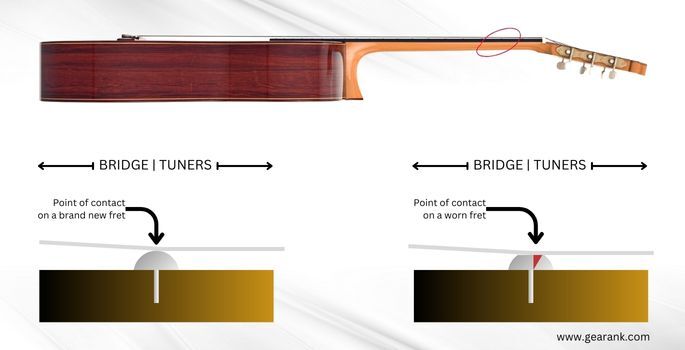
The illustration above shows how the strings make contact with the fret wires. As such, fret wires impact intonation.
The ideal point of contact is in the middle, where the string is cut short at the right length for proper intonation.
When your fret wires are worn out, the point of contact shifts slightly away from the center. This causes the notes you play to be slightly out of tune. This is why replacing worn frets is important.
Pitch changes can be very minute and almost negligible. However, to a trained ear, this change can be bothersome.
But not all intonation issues can be blamed on bad fret wires. You should also consider truss rod adjustment, especially if the neck relief is already too high or too low.
How Many Frets Does My Guitar Have?
In this section, we will feature some of the most common guitar types and the number of frets they have.
Classical Guitars
A classical guitar typically has 19–20 frets, with 19 being the most common.
The neck of a classical guitar joins the body at the 12 fret. This makes the upper frets hard to reach.
Traditional classical guitars don't have cutaways, but some acoustic-electric models have them for easier upper fret access.
Acoustic Guitars
Acoustic guitars typically have 20 frets. The neck joint is usually at the 14th fret, so you get more notes unimpeded by the body. But there are some acoustics with a 12th fret neck joint.
Cutaway models are now common among acoustic guitars, so you can reach the upper frets, but not as easily as you would on electric guitars.
Electric Guitars
Among these guitar types, electric guitars have the most variety of fret numbers. Below are some of the most common configurations.
20-22 Fender Telecasters, Strats, and Les Pauls
22-24 Ibanez, Jackson, and Kramer
Some electric guitars feature uniquely shaped frets, like the ones found on scalloped fretboard models. The wood is scalloped to make so you can fret the strings with less finger pressure. But this configuration allows for faster playing, but it requires more finesse and finger control.
Common Fret Wire Materials
Nickel Silver - German Silver, AKA Nickel Silver Alloy contrary to its name doesn't have any silver in it. Instead, this metal strip is made up of mainly copper with smaller amounts of nickel and zinc. It has a silver-like appearance, hence, the name.
This type of metal is very popular because it's inexpensive, and most importantly, easier to work on.
Fretting and re-fretting guitars is time-consuming and requires a lot of effort. A pliable nickel silver makes a luthier's work easier. That's why it's the preferred material for guitar frets.
On the downside, this metal can feel a bit draggy or have a bit of resistance. You can notice it, particularly when you're bending or sliding.
It's more susceptible to wear. So, if you play frequently, aggressively, or if you're a professional musician, you might want to consider the next one.
Stainless Steel - As a guitar player who plays or wants to play a lot, it's ideal to use stainless steel frets. These types of frets wear slower and last longer compared to nickel-silver wires.
It also makes for smoother string bending and sliding, which is great, especially for pros who utilize advanced guitar techniques.
These types of materials are extremely hard and reliable, but this also means they are challenging to install and level. Stainless steel can also cause damage to a luthier's tools, not to mention that the fret itself is quite expensive.
Other Fret Wire Options
Evogold – No, this isn't actual gold. Jescar Evogold or Evogold is a mix of copper, tin, iron, and titanium. This fret wire is hypoallergenic, which is beneficial, especially for people with nickel allergies.
Evogold is also a bit harder than nickel silver but more pliable than stainless steel. When it comes to feel, it's also in the middle of what nickel silver, and stainless steel feel like.
Brass - It's the most pliable metal among all the 4 types. This means it wears the fastest too, especially if you use steel strings. That said, brass frets are uncommon on modern guitars compared to nickel silver or stainless steel.
Brass frets are commonly used on gentler strings like catgut and nylon strings.
Fret Wire Sizes
There are plenty of variations when it comes to how thick and how tall fret wires are. Below are some of the more common ones.
Small (.078″ x .043″) - these are the fret wires found on older Fender necks. Easy to bend and has a smooth feel, but not as long lasting.
Modern narrow and tall (.090″ x .055″) - popular among modern guitarists, easy to bend, and good fretted note accuracy.
Vintage Jumbo (.102″ x .042″). Medium-sized frets provide a balance between playability and longevity.
Jumbo Frets (.110″ x .055″) & Medium Jumbo (.106″ x .036″). The largest fret wires that are available today. They are sturdy and wear down slower, making them suitable for heavy gauge guitars and basses.
Insights
-
The Guitar's fretboard or fingerboard is the wooden block to which the frets are attached.
-
Narrower frets will generally last longer compared to the flatter ones.
-
Aside from intonation problems, uneven frets can also cause fret buzz. However, aside from uneven frets, fret buzz can also be caused by low action or a back-bowed neck, among others. So, check your guitar for possible causes.
Final Thoughts
Guitar frets are integral to proper playing of notes, chords, bends, slides, and other guitar techniques.
Frets give you a musical map of your fretboard, so you know where each notes are. And the fret wires directly impact intonation as well as playing feel.
And now that you know all this, you'll no longer look at your frets the same way again.
On a personal note, I'm impressed at how the playability of my guitar improved after I had it fitted with stainless steel frets.
Frequently Asked Questions
What is a Fretless Guitar?
Fretless guitars are guitars with no frets. This distinction gives them unique characteristics that set them apart from traditional fretted guitars.
In a regular guitar, each fret is equivalent to a semitone and as you fret, the string vibrates from the bridge to the fret you're pressing. This cuts the length of the string and allows for an accurate note.
On a fretless guitar tonal restrictions brought by the frets are removed. This means you can go outside the regular semitones of a guitar and try microtonal notes.
What are Microtones?
Microtones refer to musical intervals that are less than a semitone. Applying the same concept, a guitar with microtonal frets enables you to play notes that are not usually found in standard Western music.
This is particularly useful if you want to explore other styles of music.
Does Scale Length Determine the Number of Frets?
No, scale length alone does not affect the number of frets.
For example, a 25.5" scale Ibanez usually has 24 frets, while a 25.5" scale Fender Strat usually has 21 frets. In addition, a 22.5” short-scale Jackson can have 24 frets, while a Les Paul with the same scale length will only have up to 22 frets most of the time.
Scale length together with the total length of the fretboard will affect the number of frets.
Contributors:
Jerome Arcon - Co-writer
Jerry Borillo - Illustrator



